1993 DODGE TRUCK radiator
[x] Cancel search: radiatorPage 1388 of 1502

•
BODY
COMPONENTS
23 - 5
(5)
If
necessary, align
the
hood,
the
latch,
and the
striker. Refer
to
Fore/Aft
And
Latch/Striker Adjust
ment.
BOLT
CABLE
SHIELD
RADIATOR
GRILL SUPPORT
RB1346
Fig.
11
Hood
Latch
&
Release
Cable
HOOD
INSIDE
RELEASE
CABLE
REMOWAL
(1) Open
and
support
the
hood.
(2) Disconnect release cable from
the
hood latch.
(3) Detach
the
release cable from
the
clip
in the
engine compartment
(Fig. 12).
(4)
Separate
the
release cable grommet from
the
dash panel hole.
(5) From inside
the
vehicle, remove
the
screws.
Re
move
the
release cable handle bracket from
the
bot
tom
of the
instrument panel.
(6) Route
the
hood release cable through
the
dash
panel hole. Remove
it via the
inside
of the
vehicle.
INSTALLATION (1) Route
the
hood release cable through
the
hole
in
the
dash panel.
(2) Position
the
release cable handle
at the
bottom
of
the
instrument panel. Install
the
screws. Tighten
the screws
to 11 Nem (95 in. lbs.)
torque.
(3) Install
the
cable grommet
in the
dash panel
hole
(Fig. 12).
(4)
Attach
the
cable
to the
rear clip
in the
engine
compartment. (5) Route
the
cable under
the
radiator support
panel flange. Attach
it to the
clip
and
then connect
it
to
the
hood latch.
(6) Adjust
the
latch cable.
(7) Test
the
hood latch release cable
for
proper
op
eration.
RELEASE
CABLE
HANDLE
BRACKET
HOOD
LATCH
RADIATOR
BAFFLE PANEL
J9123-376
Fig.
12
Release
Cable Removal/Installation
LOCATOR
CLIP
HOOD
LATCH
RELEASE
CABLE
BRACKET
INSTRUMENT
PANEL
LOWER
REINFORCEMENT
BRACKET
RWAL BRAKE
TEST CONNECTOR
J9123-360
Fig.
13
Release
Cable Handle Bracket
&
RWAL
Brake
Test
Connector
HOOD
POSITION ADJUSTMENT The hood hinge bolt holes
are
oversize
and
elon
gated
for
ease
of
adjustment
(Fig. 15).
Loosen
the
hinge bolts
at the
fender
for
up/down adjustment.
Loosen
the
hinge bolts
at the
hood
for
front/back
ad
justment.
REMOVAL (1) Raise
and
support
the
hood
at the
full-open
po
sition. (2)
If
equipped, disconnect
the
underhood lamp
wire connector
(Fig. 16).
(3) With
the aid of an
assistant, remove
the
hinge
arm-to-hood bolts. Remove
the
hood from vehicle.
Page 1389 of 1502

23
- 6
BODY
COMPONENTS
•
INSTRUMENT
PANEL
COWL
PANEL
REGULATOR
BRACKET
J9123-437
Fig.
14 Release Cable Handle Bracket &
Diesel
Engine
Speed
Control Regulator Bracket (4) If a replacement hood is being installed, trans
fer the underhood lamp and the insulator panel (Fig.
17).
(5) Test the hood hinges for correct operation.
(6) Lubricate the hood hinges with engine oil.
INSTALLATION
(1) With the aid of an assistant, position the hood
on the vehicle. Align the hood bolt holes with the
hinge arm holes. Install and finger-tighten the bolts. (2) Align the hood, the latch, and the striker.
HINGE
REPLACEMENT
REMOVAL
If both hinges are being replaced, remove the
hood and both hinges as a unit. If only one
hinge is being replaced, use the following proce dure. (1) Raise and support the hood at the full-open po
sition. (2) Mark the position of the hinge bolts. Loosen
the bolts (Fig. 15). (3) Support the hood at the side being removed.
Remove the bolts and hinge from the hood and
fender panel.
INSTALLATION
(1) Position the replacement hinge against the
fender panel. Install and finger-tighten the bolts. (2) Align the hood bolt holes with the marks.
(3) Tighten the hinge bolts to 23 N-m (200 in. lbs.)
torque.
LATCH STRIKER
LATCH SAFETY SUPPORT HOOD
STRIKER
LATCH PANEL HINGE
J9123-375
Fig.
16
Underhood
Lamp
INSTALLATION
(1) Position the striker on the hood.
(2) Install and tighten the screws.
HOOD SUPPORT ROD
REMOVAL
(1) Raise and support the hood.
(2) Drill out the support rod rivet from the radia
tor support panel. (3) Remove the support rod from the radiator sup
port panel.
INSTALLATION
(1) Position the support rod on the radiator support
panel. (2) Install the rivet to attach the rod to the panel.
REMOVAL
(1) Raise and support the hood.
(2) Remove the screws and the latch striker from
the hood.
Page 1391 of 1502
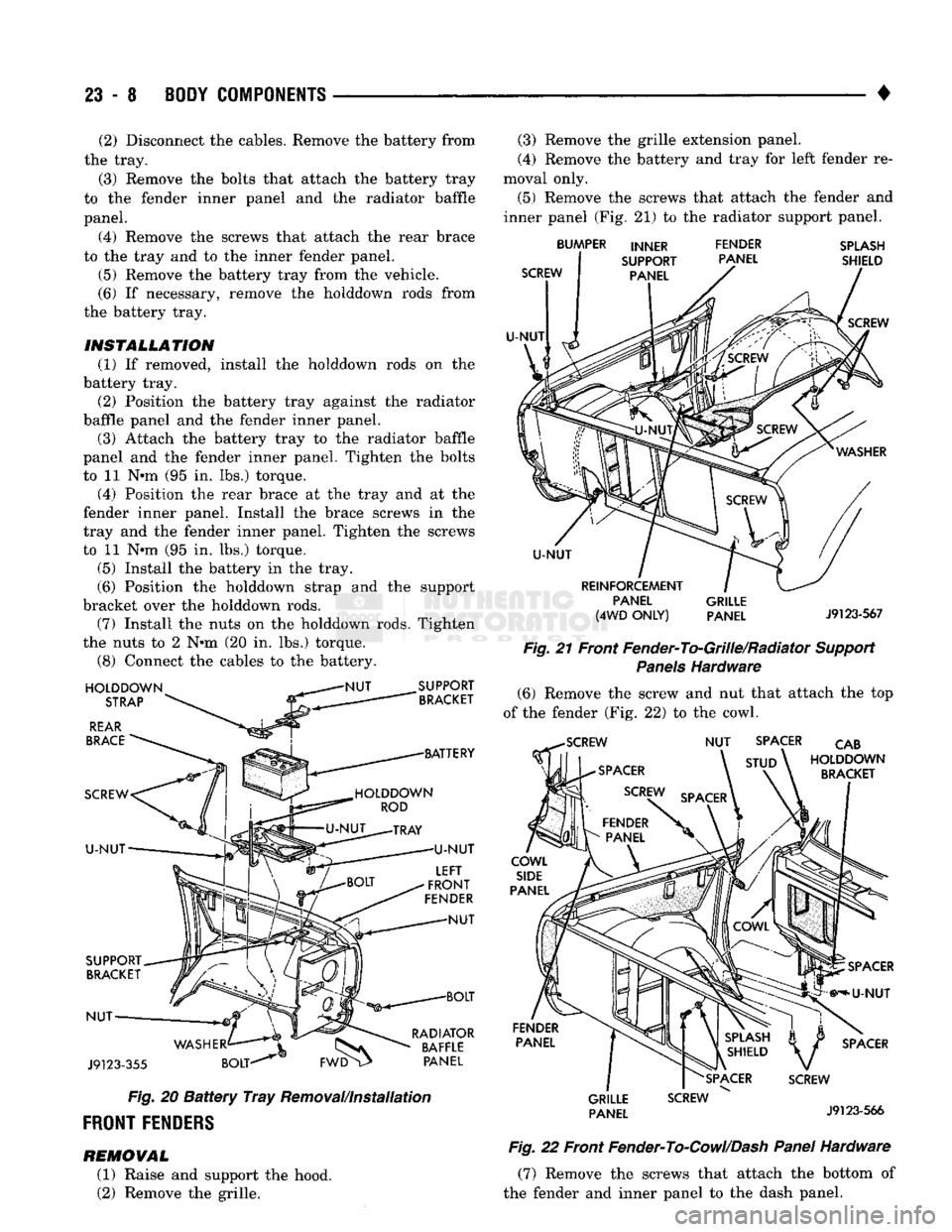
23
- 8
BODY COMPONENTS
• (2) Disconnect the cables. Remove the battery from
the tray.
(3) Remove the bolts that attach the battery tray
to the fender inner panel and the radiator baffle
panel.
(4) Remove the screws that attach the rear brace
to the tray and to the inner fender panel. (5) Remove the battery tray from the vehicle.
(6) If necessary, remove the holddown rods from
the battery tray.
INSTALLATION (1) If removed, install the holddown rods on the
battery tray. (2) Position the battery tray against the radiator
baffle panel and the fender inner panel.
(3) Attach the battery tray to the radiator baffle
panel and the fender inner panel. Tighten the bolts
to 11 N«m (95 in. lbs.) torque.
(4) Position the rear brace at the tray and at the
fender inner panel. Install the brace screws in the
tray and the fender inner panel. Tighten the screws
to 11 N*m (95 in. lbs.) torque.
(5) Install the battery in the tray.
(6) Position the holddown strap and the support
bracket over the holddown rods.
(7) Install the nuts on the holddown rods. Tighten
the nuts to 2 N»m (20 in. lbs.) torque.
(8) Connect the cables to the battery.
HOLDDOWN
STRAP
REAR
BRACE
NUT
SUPPORT
'BRACKET
BATTERY
SCREW
U-NUT
SUPPORT BRACKET
NUT-
J9123-355
WASHER^—
BOLT-^
FWD
U-NUT
LEFT
FRONT
FENDER
NUT
BOLT RADIATOR
BAFFLE PANEL
Fig. 20
Battery
Tray
Removal/Installation
FRONT
FENDERS
(3) Remove the grille extension panel.
(4) Remove the battery and tray for left fender re
moval only. (5) Remove the screws that attach the fender and
inner panel (Fig. 21) to the radiator support panel.
SCREW
U-NUT
BUMPER INNER FENDER
SUPPORT PANEL PANEL SPLASH
SHIELD
SCREW
U-NUT
REINFORCEMENT PANEL
(4WD
ONLY)
GRILLE
PANEL
J9123-567
Fig. 21 Front Fender-To-Grille/Radiator Support Panels Hardware (6) Remove the screw and nut that attach the top
of the fender (Fig. 22) to the cowl.
-SCREW
NUT
SPACER CAB
STUD
\ HOLDDOWN BRACKET
COWL
SIDE
PANEL
FENDER PANEL SPACER
GRILLE PANEL
V
SPACER SCREW
SCREW
J9123-566
Fig.
22 Front
Fender-To-Cowl/Dash
Panel Hardware (7) Remove the screws that attach the bottom of
the fender and inner panel to the dash panel. REMOWAL
(1) Raise and support the hood.
(2) Remove the grille.
Page 1392 of 1502
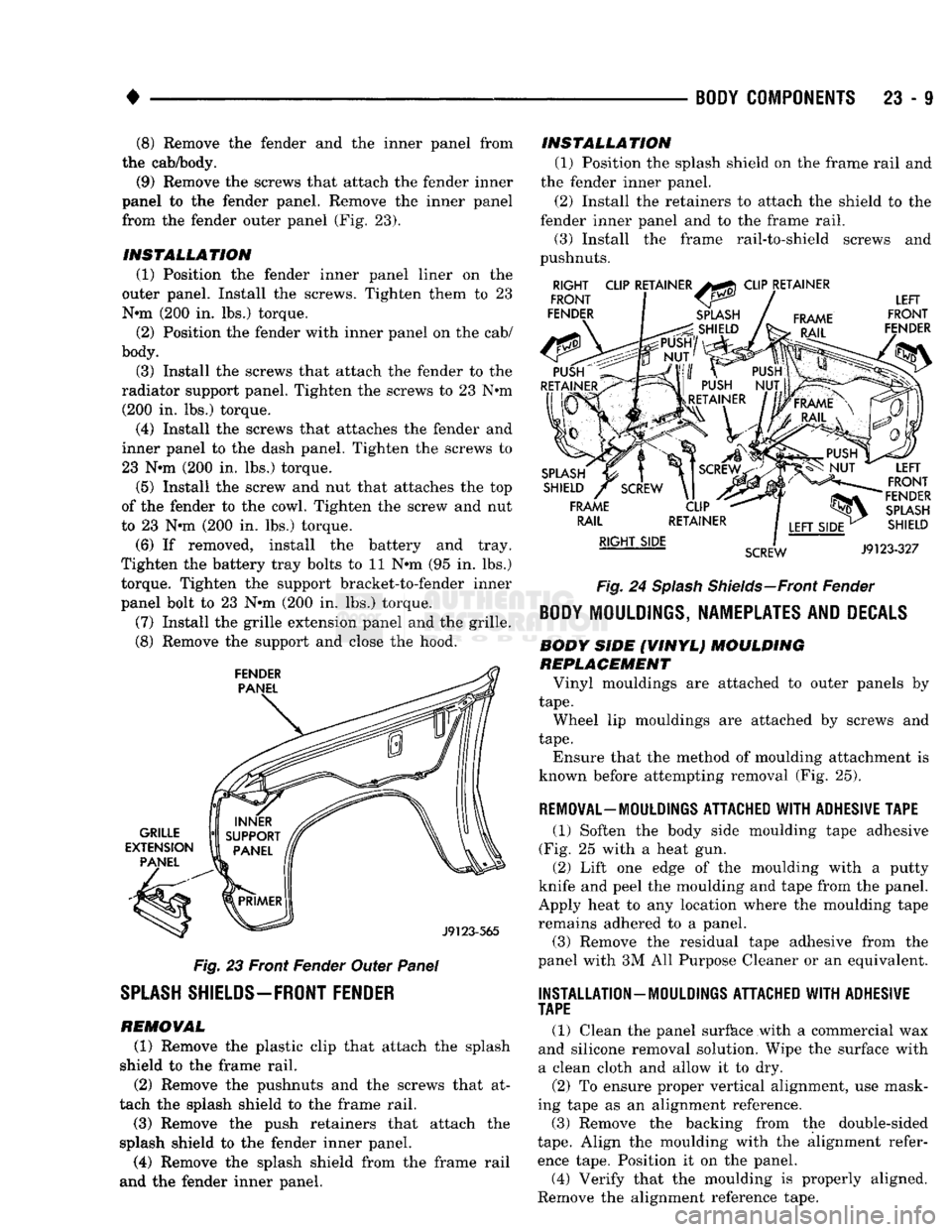
•
BODY
COMPONENTS
23 - 9 (8) Remove the fender and the inner panel from
the cab/body.
(9) Remove the screws that attach the fender inner
panel to the fender panel. Remove the inner panel from the fender outer panel (Fig. 23).
INSTALLATION (1) Position the fender inner panel liner on the
outer panel. Install the screws. Tighten them to 23
N-m (200 in. lbs.) torque.
(2) Position the fender with inner panel on the cab/
body.
(3) Install the screws that attach the fender to the
radiator support panel. Tighten the screws to 23 N-m (200 in. lbs.) torque.
(4) Install the screws that attaches the fender and
inner panel to the dash panel. Tighten the screws to
23 N-m (200 in. lbs.) torque.
(5)
Install the screw and nut that attaches the top
of the fender to the cowl. Tighten the screw and nut
to 23 N-m (200 in. lbs.) torque. (6) If removed, install the battery and tray.
Tighten the battery tray bolts to 11 N-m (95 in. lbs.)
torque. Tighten the support bracket-to-fender inner panel bolt to 23 N-m (200 in. lbs.) torque.
(7) Install the grille extension panel and the grille.
(8) Remove the support and close the hood.
FENDER
PANEL
GRILLE
EXTENSION PANEL
J9123-565
Fig.
23 Front Fender Outer Panel
SPLASH
SHIELDS—FRONT
FENDER
REMOVAL (1) Remove the plastic clip that attach the splash
shield to the frame rail. (2) Remove the pushnuts and the screws that at
tach the splash shield to the frame rail. (3) Remove the push retainers that attach the
splash shield to the fender inner panel. (4) Remove the splash shield from the frame rail
and the fender inner panel. INSTALLATION
(1) Position the splash shield on the frame rail and
the fender inner panel.
(2) Install the retainers to attach the shield to the
fender inner panel and to the frame rail. (3) Install the frame rail-to-shield screws and
pushnuts.
RIGHT
FRONT
FENDER CLIP RETAINER
CLIP RETAINER
FRAME LEFT
FRONT
FENDER
SPLASH
SHIELD
FRAME RAIL
RIGHT SIDE
SCREW
LEFT
FRONT
FENDER
SPLASH
SHIELD
J9123-327
Fig.
24
Splash
Shields—Front
Fender
BODY
MOULDINGS, NAMEPLATES AND
DECALS
BODY SIDE (VINYL) MOULDING
REPLACEMENT
Vinyl mouldings are attached to outer panels by
tape.
Wheel lip mouldings are attached by screws and
tape.
Ensure that the method of moulding attachment is
known before attempting removal (Fig. 25).
REMOVAL—MOULDINGS
ATTACHED WITH ADHESIVE TAPE
(1) Soften the body side moulding tape adhesive
(Fig. 25 with a heat gun. (2) Lift one edge of the moulding with a putty
knife and peel the moulding and tape from the panel.
Apply heat to any location where the moulding tape remains adhered to a panel.
(3) Remove the residual tape adhesive from the
panel with 3M All Purpose Cleaner or an equivalent.
INSTALLATION
—
MOULDINGS
ATTACHED WITH ADHESIVE
TAPE
(1) Clean the panel surface with a commercial wax
and silicone removal solution. Wipe the surface with
a clean cloth and allow it to dry.
(2) To ensure proper vertical alignment, use mask
ing tape as an alignment reference.
(3) Remove the backing from the double-sided
tape.
Align the moulding with the alignment refer
ence tape. Position it on the panel.
(4) Verify that the moulding is properly aligned.
Remove the alignment reference tape.
Page 1438 of 1502
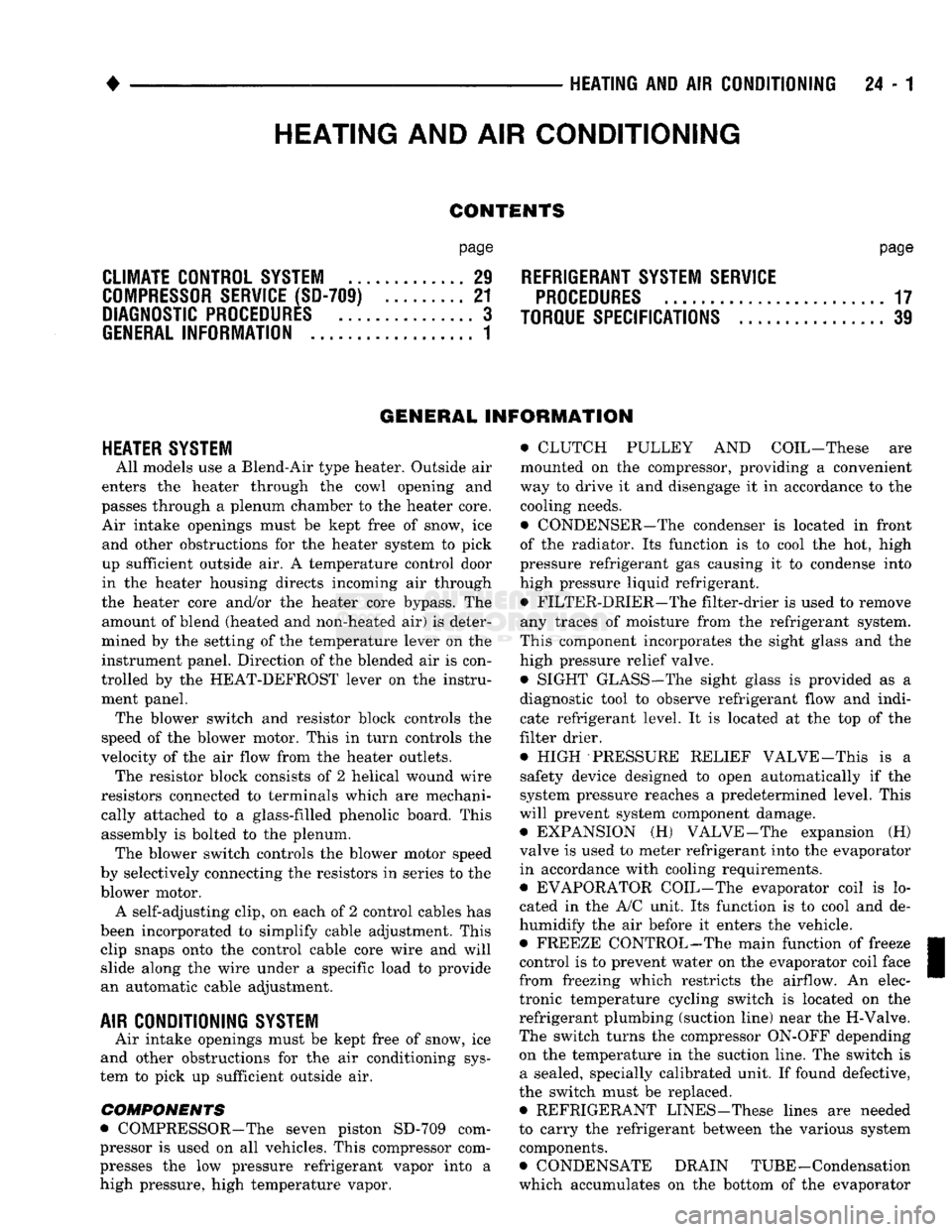
•
• —• •
HEATING
AND AIR
CONDITIONING
24 - 1 CONTENTS
page
CLIMATE CONTROL SYSTEM
............. 21
REFRIGERANT SYSTEM SERWICE
COMPRESSOR
SERWICE
(SD-709)
......... 21
PROCEDURES
.............
DIAGNOSTIC PROCEDURES
3
TORQUE SPECIFICATIONS
GENERAL INFORMATION
1
page
. 17
. 31
GENERAL INFORMATION
HEATER SYSTEM
All models use a Blend-Air type heater. Outside air
enters the heater through the cowl opening and
passes through a plenum chamber to the heater core. Air intake openings must be kept free of snow, ice and other obstructions for the heater system to pick
up sufficient outside air. A temperature control door
in the heater housing directs incoming air through
the heater core and/or the heater core bypass. The amount of blend (heated and non-heated air) is deter
mined by the setting of the temperature lever on the
instrument panel. Direction of the blended air is con
trolled by the HEAT-DEFROST lever on the instru ment panel. The blower switch and resistor block controls the
speed of the blower motor. This in turn controls the
velocity of the air flow from the heater outlets. The resistor block consists of 2 helical wound wire
resistors connected to terminals which are mechani cally attached to a glass-filled phenolic board. This
assembly is bolted to the plenum. The blower switch controls the blower motor speed
by selectively connecting the resistors in series to the
blower motor.
A self-adjusting clip, on each of 2 control cables has
been incorporated to simplify cable adjustment. This clip snaps onto the control cable core wire and will slide along the wire under a specific load to provide
an automatic cable adjustment.
AIR
CONDITIONING
SYSTEM
Air intake openings must be kept free of snow, ice
and other obstructions for the air conditioning sys
tem to pick up sufficient outside air.
COMPONENTS
• COMPRESSOR-The seven piston SD-709 com
pressor is used on all vehicles. This compressor com
presses the low pressure refrigerant vapor into a high pressure, high temperature vapor. • CLUTCH PULLEY AND COIL-These are
mounted on the compressor, providing a convenient
way to drive it and disengage it in accordance to the cooling needs.
• CONDENSER-The condenser is located in front
of the radiator. Its function is to cool the hot, high
pressure refrigerant gas causing it to condense into
high pressure liquid refrigerant.
• FILTER-DRIER—The filter-drier is used to remove
any traces of moisture from the refrigerant system.
This component incorporates the sight glass and the
high pressure relief valve.
• SIGHT GLASS-The sight glass is provided as a
diagnostic tool to observe refrigerant flow and indi cate refrigerant level. It is located at the top of the
filter drier.
• HIGH -PRESSURE RELIEF VALVE-This is a safety device designed to open automatically if the
system pressure reaches a predetermined level. This
will prevent system component damage. • EXPANSION (H) VALVE-The expansion (H)
valve is used to meter refrigerant into the evaporator
in accordance with cooling requirements. • EVAPORATOR COIL-The evaporator coil is lo
cated in the A/C unit. Its function is to cool and de-
humidify the air before it enters the vehicle. • FREEZE CONTROL-The main function of freeze
control is to prevent water on the evaporator coil face
from freezing which restricts the airflow. An elec
tronic temperature cycling switch is located on the
refrigerant plumbing (suction line) near the H-Valve.
The switch turns the compressor ON-OFF depending
on the temperature in the suction line. The switch is a sealed, specially calibrated unit. If found defective,
the switch must be replaced. • REFRIGERANT LINES-These lines are needed
to carry the refrigerant between the various system components.
• CONDENSATE DRAIN TUBE-Condensation
which accumulates on the bottom of the evaporator
HEATING
AND AIR
CONDITIONING
Page 1439 of 1502
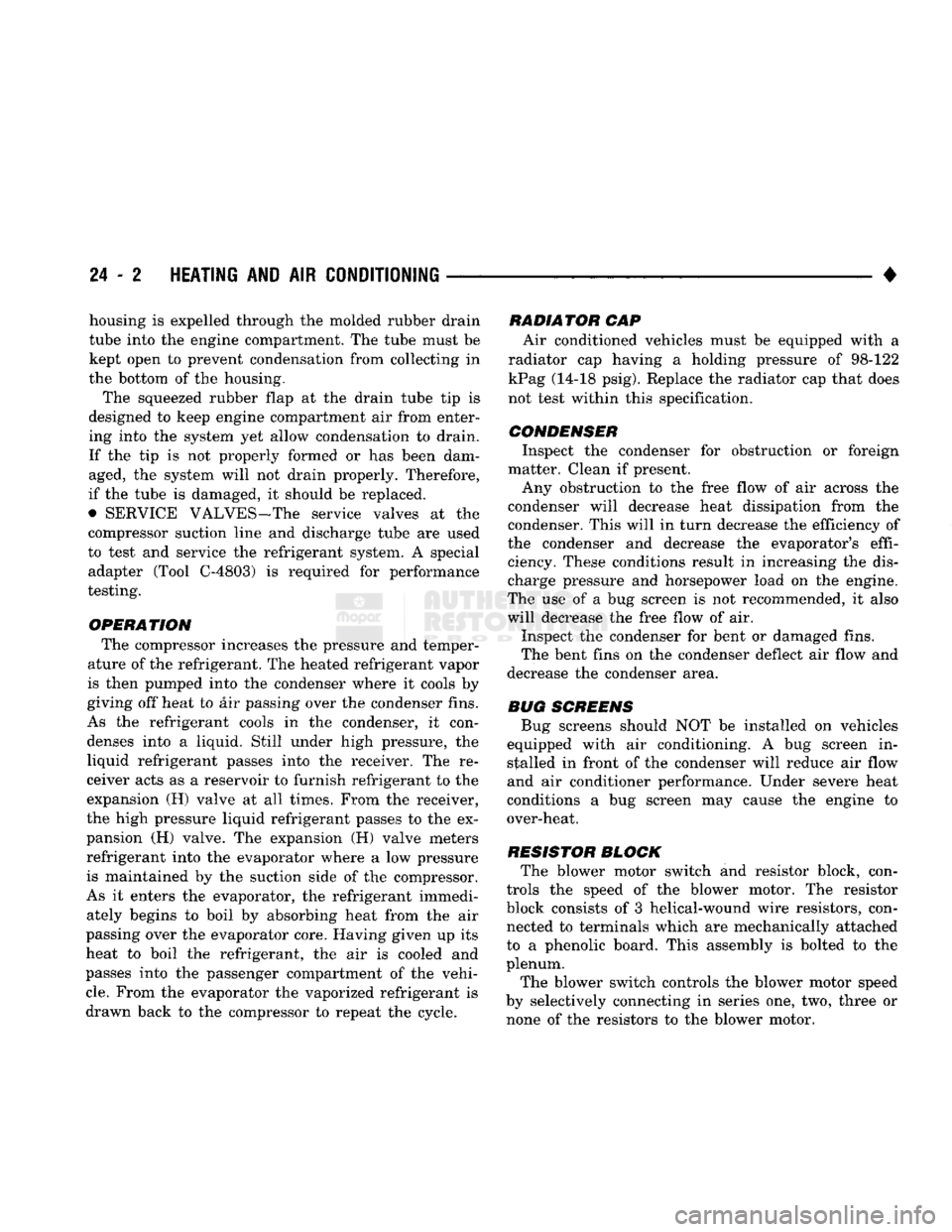
24 - 2
HEATING
AND AIR
CONDITIONING
• housing is expelled through the molded rubber drain
tube into the engine compartment. The tube must be
kept open to prevent condensation from collecting in
the bottom of the housing.
The squeezed rubber flap at the drain tube tip is
designed to keep engine compartment air from enter ing into the system yet allow condensation to drain.
If the tip is not properly formed or has been dam
aged, the system will not drain properly. Therefore,
if the tube is damaged, it should be replaced.
• SERVICE VALVES—The service valves at the
compressor suction line and discharge tube are used
to test and service the refrigerant system. A special adapter (Tool C-4803) is required for performance
testing.
OPERATION The compressor increases the pressure and temper
ature of the refrigerant. The heated refrigerant vapor
is then pumped into the condenser where it cools by
giving off heat to air passing over the condenser fins.
As the refrigerant cools in the condenser, it con
denses into a liquid. Still under high pressure, the
liquid refrigerant passes into the receiver. The re
ceiver acts as a reservoir to furnish refrigerant to the
expansion (H) valve at all times. From the receiver,
the high pressure liquid refrigerant passes to the ex pansion (H) valve. The expansion (H) valve meters
refrigerant into the evaporator where a low pressure
is maintained by the suction side of the compressor.
As it enters the evaporator, the refrigerant immedi ately begins to boil by absorbing heat from the air
passing over the evaporator core. Having given up its
heat to boil the refrigerant, the air is cooled and
passes into the passenger compartment of the vehi
cle.
From the evaporator the vaporized refrigerant is
drawn back to the compressor to repeat the cycle. RADIATOR CAP
Air conditioned vehicles must be equipped with a
radiator cap having a holding pressure of 98-122 kPag (14-18 psig). Replace the radiator cap that does
not test within this specification.
CONDENSER Inspect the condenser for obstruction or foreign
matter. Clean if present.
Any obstruction to the free flow of air across the
condenser will decrease heat dissipation from the
condenser. This will in turn decrease the efficiency of
the condenser and decrease the evaporator's effi
ciency. These conditions result in increasing the dis
charge pressure and horsepower load on the engine.
The use of a bug screen is not recommended, it also
will decrease the free flow of air.
Inspect the condenser for bent or damaged fins.
The bent fins on the condenser deflect air flow and
decrease the condenser area.
BUG SCREENS Bug screens should NOT be installed on vehicles
equipped with air conditioning. A bug screen in
stalled in front of the condenser will reduce air flow
and air conditioner performance. Under severe heat
conditions a bug screen may cause the engine to
over-heat.
RESISTOR
BLOCK
The blower motor switch and resistor block, con
trols the speed of the blower motor. The resistor
block consists of 3 helical-wound wire resistors, con nected to terminals which are mechanically attached
to a phenolic board. This assembly is bolted to the
plenum.
The blower switch controls the blower motor speed
by selectively connecting in series one, two, three or none of the resistors to the blower motor.
Page 1440 of 1502
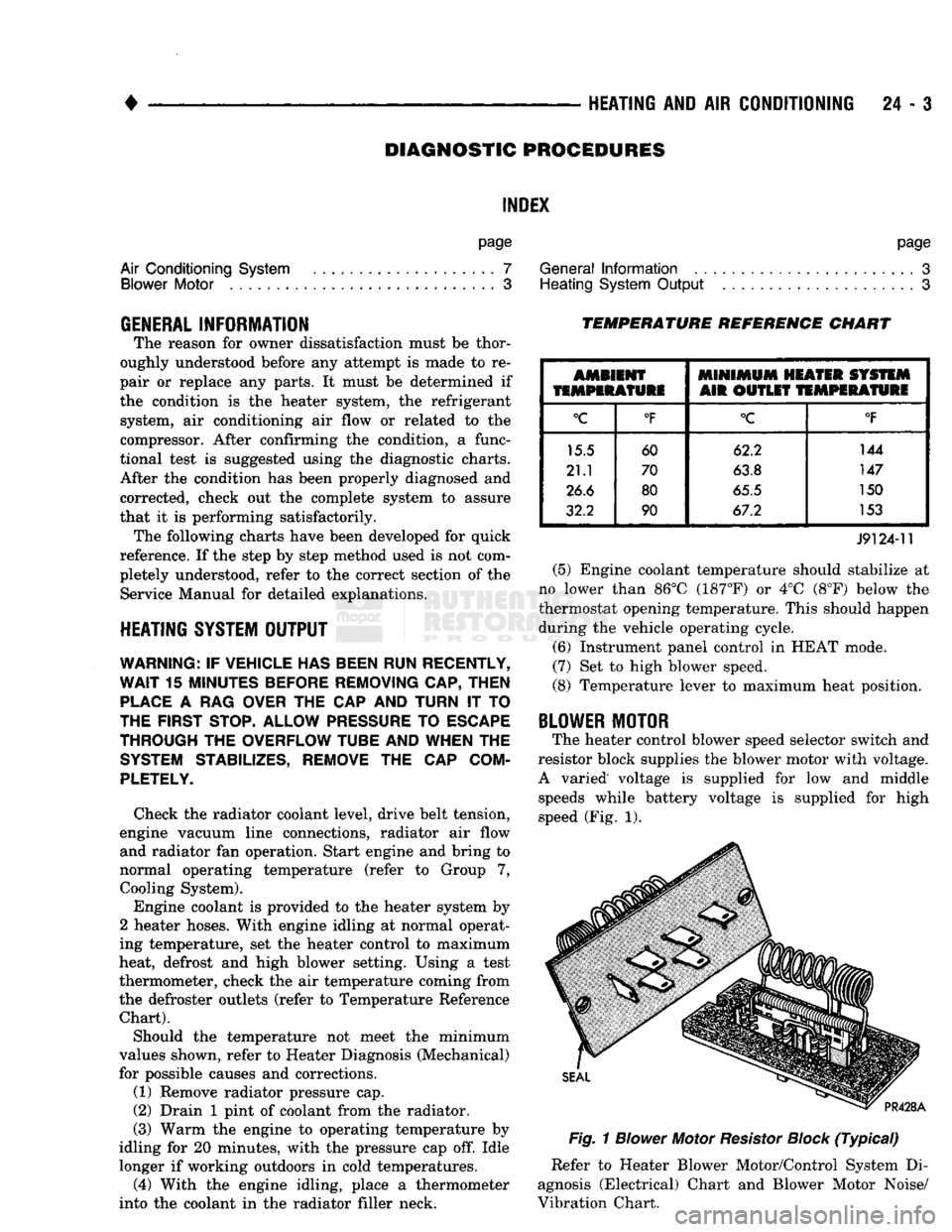
•
HEATING
AND AIR
CONDITIONING
24 - 3
DIAGNOSTIC
PROCEDURES
INDEX
page
page ..
7
General Information
3
.
. 3
Heating System Output
3
Air
Conditioning System
Blower
Motor
GENERAL
INFORMATION
The reason for owner dissatisfaction must be thor
oughly understood before any attempt is made to re
pair or replace any parts. It must be determined if
the condition is the heater system, the refrigerant system, air conditioning air flow or related to the
compressor. After confirming the condition, a func
tional test is suggested using the diagnostic charts.
After the condition has been properly diagnosed and corrected, check out the complete system to assure
that it is performing satisfactorily. The following charts have been developed for quick
reference. If the step by step method used is not com pletely understood, refer to the correct section of the Service Manual for detailed explanations.
HEATING
SYSTEM
OUTPUT
WARNING:
IF
VEHICLE
HAS
BEEN
RUN
RECENTLY,
WAIT
15
MINUTES
BEFORE
REMOVING
CAP, THEN
PLACE
A RAG
OVER
THE CAP AND
TURN
IT TO
THE
FIRST
STOP.
ALLOW
PRESSURE
TO
ESCAPE
THROUGH
THE
OVERFLOW
TUBE
AND
WHEN
THE
SYSTEM
STABILIZES,
REMOVE
THE CAP
COM
PLETELY.
Check the radiator coolant level, drive belt tension,
engine vacuum line connections, radiator air flow and radiator fan operation. Start engine and bring to
normal operating temperature (refer to Group 7,
Cooling System).
Engine coolant is provided to the heater system by
2 heater hoses. With engine idling at normal operat
ing temperature, set the heater control to maximum
heat, defrost and high blower setting. Using a test
thermometer, check the air temperature coming from
the defroster outlets (refer to Temperature Reference Chart).
Should the temperature not meet the minimum
values shown, refer to Heater Diagnosis (Mechanical)
for possible causes and corrections.
(1) Remove radiator pressure cap.
(2) Drain 1 pint of coolant from the radiator.
(3) Warm the engine to operating temperature by
idling for 20 minutes, with the pressure cap off. Idle longer if working outdoors in cold temperatures. (4) With the engine idling, place a thermometer
into the coolant in the radiator filler neck.
TEMPERATURE REFERENCE CHART
AMBIENT
MINIMUM
HEATER SYSTEM
TEMPERATURE
AIR OUTLET
TEMPERATURE
°C
°F
°C
°F
15.5 60 62.2 144
21.1 70
63.8 147
26.6 80
65.5 150
32.2 90 67.2 153
J9124-11
(5) Engine coolant temperature should stabilize at
no lower than 86°C (187°F) or 4°C (8°F) below the
thermostat opening temperature. This should happen during the vehicle operating cycle.
(6) Instrument panel control in HEAT mode.
(7) Set to high blower speed.
(8) Temperature lever to maximum heat position.
BLOWER
MOTOR
The heater control blower speed selector switch and
resistor block supplies the blower motor with voltage.
A varied voltage is supplied for low and middle speeds while battery voltage is supplied for high
speed (Fig. 1).
Fig.
1
Blower
Motor
Resistor
Block
(Typical)
Refer to Heater Blower Motor/Control System Di
agnosis (Electrical) Chart and Blower Motor Noise/
Vibration Chart.
Page 1443 of 1502
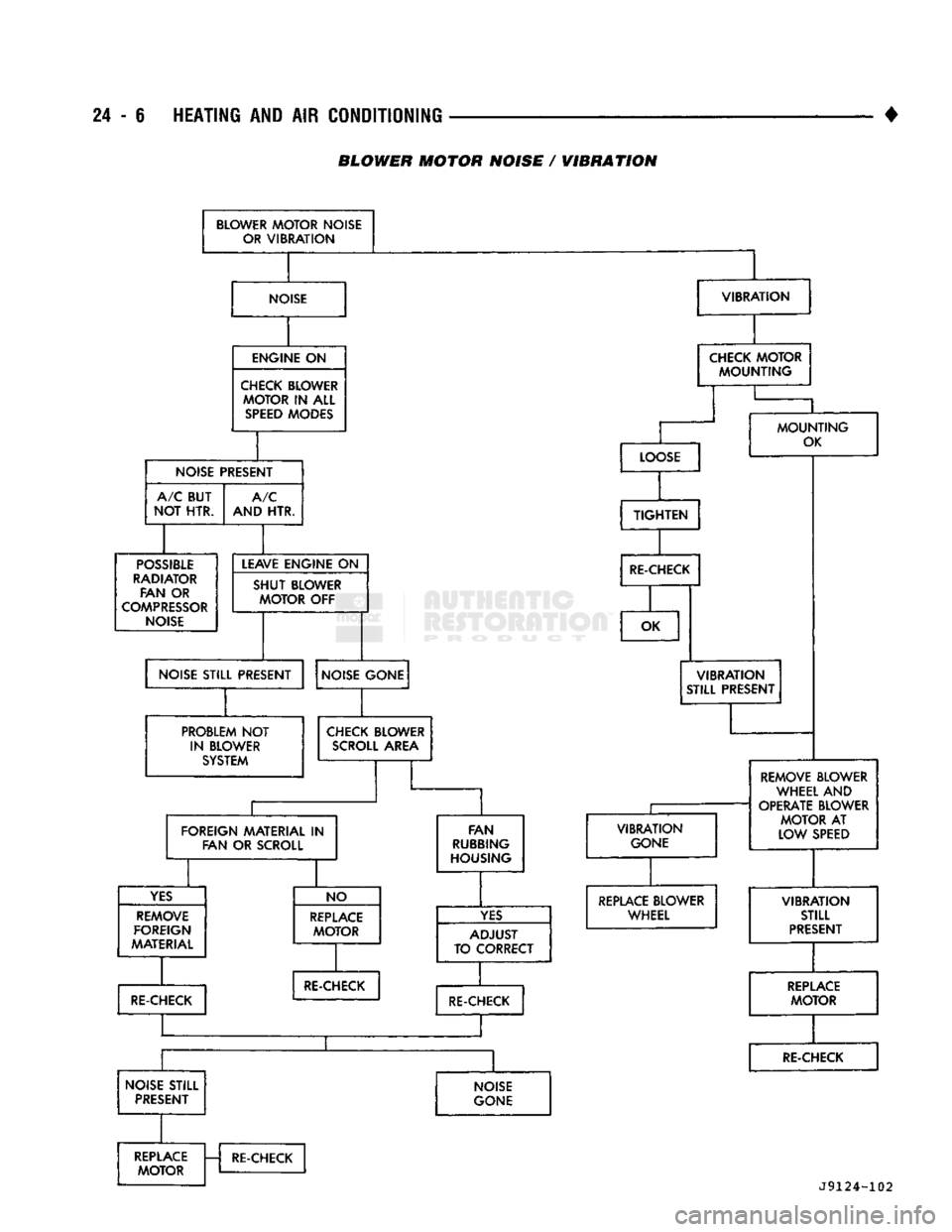
24
- 6
HEATING AND
AIR
CONDITIONING
BLOWER MOTOR NOISE / WIBRATION
BLOWER
MOTOR
NOISE
OR
VIBRATION
NOISE
VIBRATION
ENGINE
ON
CHECK BLOWER
MOTOR
IN
ALL
SPEED
MODES CHECK
MOTOR
MOUNTING
NOISE PRESEh
n
A/C BUT
NOT HTR. A/C
AND HTR.
POSSIBLE
RADIATOR FAN
OR
COMPRESSOR
NOISE LEAVE ENGINE
ON
SHUT
BLOWER
MOTOR
OFF
NOISE STILL PRESENT LO(
DSE
TIGHTEN
RE-CHECK
MOUNTING
OK
OK
NOISE GONE
PROBLEM
NOT
IN BLOWER SYSTEM
VIBRATION
STILL PRESENT
CHECK BLOWER
SCROLL
AREA
FOREIGN MATERIAL
IN
FAN
OR
SCROLL
YES
REMOVE
FOREIGN
MATERIAL FAN
RUBBING
HOUSING NO
REPLACE
MOTOR
RE-CHECK
VIBRATION
GONE
YES
A
TO
C
DJUST
ZORRECT RE-CHECK
REMOVE BLOWER
WHEEL AND
OPERATE BLOWER
MOTOR
AT
LOW SPEED REPLACE BLOWER
WHEEL
RE-CHECK
NOISE STILL PRESENT NOISE
GONE
VIBRATION
STILL
PRESENT
REPLACE
MOTOR
RE-CHECK REPLACE
MOTOR
RE-CHECK
J9124-102